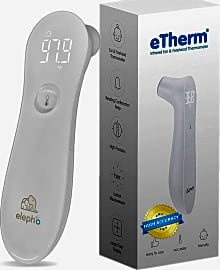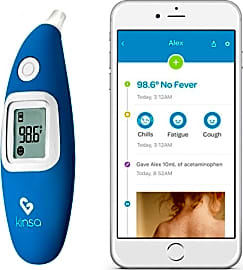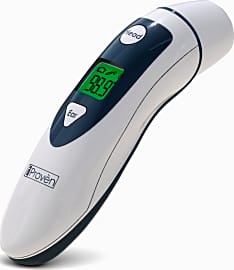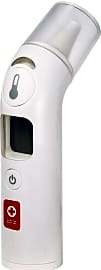The 6 Best Ear Thermometers

This wiki has been updated 41 times since it was first published in April of 2015. Ear thermometers might be more expensive than oral models, but they’re worth their weight in gold when you’re dealing with an agitated, feverish child. They deliver digital readings accurately and quickly, and some even pair with your smartphone for data management. For consistent results, be sure to consult the instructions to learn how to properly place these devices in the auditory canal. When users buy our independently chosen editorial picks, we may earn commissions to help fund the Wiki.
Editor's Notes
July 09, 2021:
We eliminated a couple generic models with questionable consistency and also rearranged our recommendations slightly. The Braun ThermoScan 7 is now at the top of the list because it's as premium as an ear thermometer gets. We also added the Elpho eTherm because it's compact, simple, and highly affordable. The Kinsa Digital Smart is also interesting because of its smartphone connectivity, so if you need to store values for long-term tracking, it's an especially convenient choice.
February 06, 2020:
As any parent can tell you, taking your child’s temperature can be stressful when they are restless and feverish. Ear thermometers can work quickly and provide accurate results, so we’ve carefully selected the best ones and listed them here. Joining the list are a few new models, two of which can be used either in the ear or on the forehead. Once such device is the Caroune Infrared, which makes it easy to keep up on your child's temperature when they are sleeping, thanks to its handy silent mode option and a bright display that you’ll read easily in the dark. The GoodBaby Dual-Function offers the same double functionality, and this one can also measure the temperature of liquids, foods, or the air in the room. Solely an ear model, The First Years American Red Cross is a great option for any nervous mom or dad who wants to make sure they’re using it correctly, as its light flashes green when it’s positioned in the ear properly. These three are more accurate, more reliable models than the ones they replace, which are the Best Medical, the EZ Temp Dual Mode, and the Loverbeby Accuracy.
The iProven Medical moves into the top spot on our list in this update, since it offers a combination of reliability and ease of use that make it a good value for it price. Like the Caroune and the GoodBaby models, this one can function as either an ear or a forehead model, and you can switch easily between the two. It has a bright lightup display, and is a good choice for you if you don’t prefer to buy replacement lens filters, like you need to do for the Braun ThermoScan 5 and the Braun ThermoScan 7. It’s all a matter of personal preference.
For a high-tech model that pairs with your smartphone to help you track all sorts of data, look to the Kinsa Digital Smart, which features a companion app that automatically stores your temperature readings and the corresponding date and time, and you can also input symptom information and what medication you gave your child, and when.
Note that the Mayo Clinic does not recommend ear thermometers for infants younger than six months of age. Be sure to check with your pediatrician on when is the best time to start using one with your baby. In addition, you should read the instructions carefully to make sure you are using this device correctly in order to get a proper reading.
For more options when it comes to oral, rectal, ear, and forehead thermometers, see our list of the best digital thermometers.
Special Honors
Up & Up Digital Thermometer For use either on the ear or the forehead, this instant-read model is handy to have around when you have an agitated and feverish child. It will provide results quickly and is comfortable to use. A bright, backlit LCD allows you to see the reading without waking a sleeping baby. It can be switched easily to “object” mode, so you can measure the temperature of foods or liquids. It comes with the required batteries, instructions in both English and Spanish, and is backed by a limited one-year warranty. target.com
Walgreens Infrared Instant This certified accurate device renders a quick two-second reading clearly on its LED temperature indicator. Its memory recall function shows the last 10 temperatures, so you won’t need to take the time to write them down. You can choose to see results in either Fahrenheit or Celsius, and the screen will light up green, orange, or red to correspond with the temperature. It features a curved, ergonomic shape and comes with the required button battery. walgreens.com
What Happens In Your Body During A Fever?
Your body identifies the invader and deploys white blood cells to kick it out.
The human body has incredible ways of keeping itself alive. Millions of years of evolution have naturally selected traits and capabilities that, applied in their most extreme fashion, seem like the stuff of science fiction.
Take a broken bone, for example. When a bone breaks, the fibrous connections of which the bone is comprised have been severed. The bone itself bleeds (remember, bones are what make your blood, which is another fascinating result of evolution), and the coagulation of specialized cells around the fracture creates a safe healing environment. Over the next few weeks, your body begins to rebuild tissue around the fracture, eventually growing new bone and healing itself.
The same thing happens more visibly when you suffer an injury to your skin. That scab over a small cut creates the same quality of healing environment that surrounds a broken bone. This is why it’s usually a bad idea to pick at a scab, in addition to the fact that doing so will often result in a more visible scar.
If this kind of healing were to take place in seconds, as opposed to days and weeks, our cuts, breaks, and other injuries would pose next to no threat to our physiology beyond the psychological effects of pain. We would essentially be like Wolverine, but without the adamantium-coated skeleton.
When a pathogen enters your body, a number of things happen to fight it off. Your body identifies the invader and deploys white blood cells to kick it out. For many invaders this process goes on undetected, as your body’s innate and developed antibodies can knock out a great many potential illnesses before they take hold and cause you to develop symptoms.
If your body’s defenses aren’t up to the task invisibly, you’ll begin to notice any variety of symptoms, including a fever. Many invaders are susceptible to heightened temperatures, and the difference in body temperature between 98.6 and 102 degrees can often be enough to weaken them to the point of destruction. Your body informs the hypothalamus (one of your brain’s generals in the war against infection and the effort to maintain homeostasis) that it needs a temperature increase, and the hypothalamus accommodates. The more resilient the infection, the higher the fever is liable to rise and the longer it’s liable to last.
The Importance Of Keeping An Eye On Your Temperature
Given the knowledge that your body raises its temperature in an effort to destroy dangerous invaders, it might be tempting to pile on the blankets and turn up the heat in an attempt to burn out the infection. While the logic of this might seem sound at first, it’s important to know that your body can only withstand a certain degree of temperature increase before other parts of your physiology begin to suffer.
Monitoring a patient’s temperature throughout the course of an illness is just as vital as ascertaining it at the outset.
The dangers of a high fever are particularly potent in children and infants whose immune systems aren’t yet fully developed. While an adult can withstand body temperatures in the vicinity of 103 or 104 degrees, infants whose body temperatures exceed 100.4 degrees should immediately see a doctor, as this can be a sign of a life-threatening infection. If a child’s temperature reaches above 103 degrees, there is a significant risk of seizure.
In adults, fever from infection or a lapse in the body’s ability to regulate its temperature can result in hyperthermia. Hyperthermia is usually diagnosed in patients with temperatures in excess of 104 degrees. It can result in confusion, vomiting, rapid breathing, fainting, and even death in very young and very old patients or those with weakened immune systems.
All of these dangers make it absolutely vital that you keep an eye on the temperature of anyone who exhibits symptoms of bacterial or viral infections. Even symptoms that might be misdiagnosed as allergies (runny or stuffy nose, headache, etc.) can be the overture to a much more dangerous illness. As soon as symptoms arise, it’s important to take a patient’s temperature to ensure they aren’t at risk of developing more severe symptoms and to put them on the proper course of treatment. An in-ear thermometer is especially accurate and easy to use, making it ideal for in-home temperature monitoring.
Monitoring a patient’s temperature throughout the course of an illness is just as vital as ascertaining it at the outset. Sudden spikes in fever can indicate the body’s inability to handle an invader on its own as well as a negative reaction to an administered medication.
Illness isn’t the only time a person should have their temperature checked, either. After the introduction of new medications for anything from allergies to depression, there is the risk of significant side effects. Heat stroke is also commonly accompanied by a rise in body temperature, so if someone feels weak or faint after spending too much time outside in the heat, definitely take their temperature.
A Brief History Of Thermometers
Before the thermometer as we know it came along, several inventors including Galileo Galilei developed something known as a thermoscope. This device, which came about toward the end of the 16th century, could show its user that something was getting hotter or colder, but it contained no set measurements.
This device, which came about toward the end of the 16th century, could show its user that something was getting hotter or colder, but it contained no set measurements.
An Italian inventor named Santorio Santorio was the first man to place a scale of any kind onto a thermoscope, essentially creating the modern thermometer. It was even used to take people’s temperatures by placing it beneath their tongues.
Daniel Gabriel Fahrenheit, a German physicist active in the early 18th century, added a scale to the mercury thermometer that would remain a standard means of measurement through to today. A Swedish astronomer named Anders Celsius came along to rain on Fahrenheit’s parade, however, when he introduced a scale of his own. This system, known as the centigrade scale, became the go-to means of measurement for the majority of the world.











